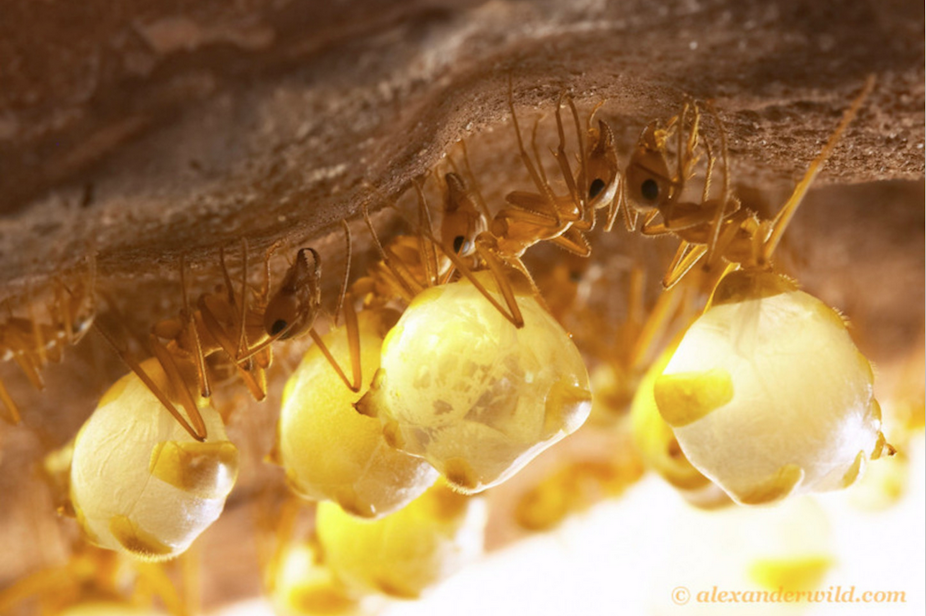Worker ants are a funny old bunch, of many shapes and sizes. But they tend to get bigger and smaller much more often than evolving entirely new shapes, according to a new study.
While most animals juggle survival with having babies, a worker ant is not constrained by also having to be a functioning mum. She can safely leave that job to the queen ant, because the queen produces the worker’s siblings, who all share her genes and thus pass on her DNA.
Although specially adapted for a life of labour, worker ants nevertheless still come in many different forms. Not constrained by the need to produce offspring, and given the many tasks workers perform, one might imagine this could lead to the evolution of some extremely strangely shaped insects.
At a cursory glance, this seems to be true in spades. Take, for instance, the turtle ant Cephalotes that nests in tree cavities. It has a dedicated caste of soldiers who are supposed to block entrances, and this they achieve by using heads that have evolved to look like manhole covers.

Or consider the honeypot ants (shown in the lead photograph), Myrmecocystus, who have abdomens that are giant distended living vats of honey.
There are also Camponotus workers that “explode” on contact with enemies, showering them with glue from a massively overdeveloped gland in their head.

These remarkable examples, however, might just be exceptions. Most worker ants have more mundane-looking features that set them apart, mostly mere variation in size. It is rare for ants to have more than one specialised kind of worker. Even the most complex societies of ants, like leafcutter ants, have at most three truly distinct kinds of workers, and these tend to vary only in size.
This discrepancy intrigued Marcio Pie and Marcel Tschá, from the Federal University of Paraná in Brazil, who have just published a study in PeerJ to find out if size actually varies more than shape. To do this, they took thousands of measurements from technical photographs of worker ants on AntBase, a repository of ant pictures and data.
And indeed it seems, at least among the workers of some 100 ant species they measured, that size was actually much more variable than shape (“shape” being measurements that don’t simply all vary in concert with each other across species).
This fact makes evolution in worker ants less special than we might expect – because variation in size is also how many other groups of animals vary most in their evolutionary history. Despite the many weird and wonderful forms of ants we know exist, it seems worker ants are no different from the rest of us when it comes to how morphology evolves.

So why does size vary so much? One theory is that size represents a “genetic line of least resistance” – ie size seems to be easy to evolve.
In the multilayered webs of interacting genes making up something as complex as an ant, not all genetic combinations exist. Some are more frequent than others. In wild populations, patterns of genetic variation are not random, but fall along well-defined axes that act as channels guiding the way the physical form can evolve. Typically, the most important is a “bigger-smaller” axis. Also, hormones control growth, and can act on many body parts at once. Genetic mutations that change hormone levels can result in big changes in size.
In a slightly more complex twist, some features grow disproportionately as animals get bigger. Just as in Alice in Wonderland, as ants become really small, tiny objects like sand grains become enormous. Under these conditions, long legs for running become less important and stubby legs are an advantage. Thus, legs are proportionally shorter in smaller ants.
And why is it that ant shapes vary so little? One theory holds that what workers lack in specialised forms, they make up for in flexible behaviour, which allows workers to respond to unpredictable environments. Ants are able to reallocate whole sections of the workforce at a moment’s notice when the need arises. For example, African driver ants (Dorylus) form living bridges when on the move, red ants (Myrmica) become undertakers and fire ants (Solenopsis) form living waterproof rafts to see the whole colony through a flood.
Another possibility hinges on the fact that ant workers are still technically capable of having offspring, and occasionally try to do so (although their offspring are all male, and are often eaten by other workers). This may mean their forms are still constrained by the need to reproduce, however meagre a brood they end up producing.
Nevertheless, in some cases, specialised ecology has selected for specialised workers. And, in keeping with this, Pie and Tschá did find a few cases of rapid shape evolution in isolated lineages, for example in fungus-farming ants (like leafcutter ants).

Shape evolution had also accelerated in another group containing weirdos such as Calyptomyrmex, some of whose members have mysterious spatula-shaped hairs covering their bodies – nobody knows what for.

The obvious next question is – does slow shape evolution go hand in hand with flexible, jack-of-all-trades workers like fire ants? Conversely, do we see the fastest shape evolution in lineages where different kinds of workers have specialised, inflexible jobs, like turtle ants? Perhaps studying some more ant pictures might answer those questions.

